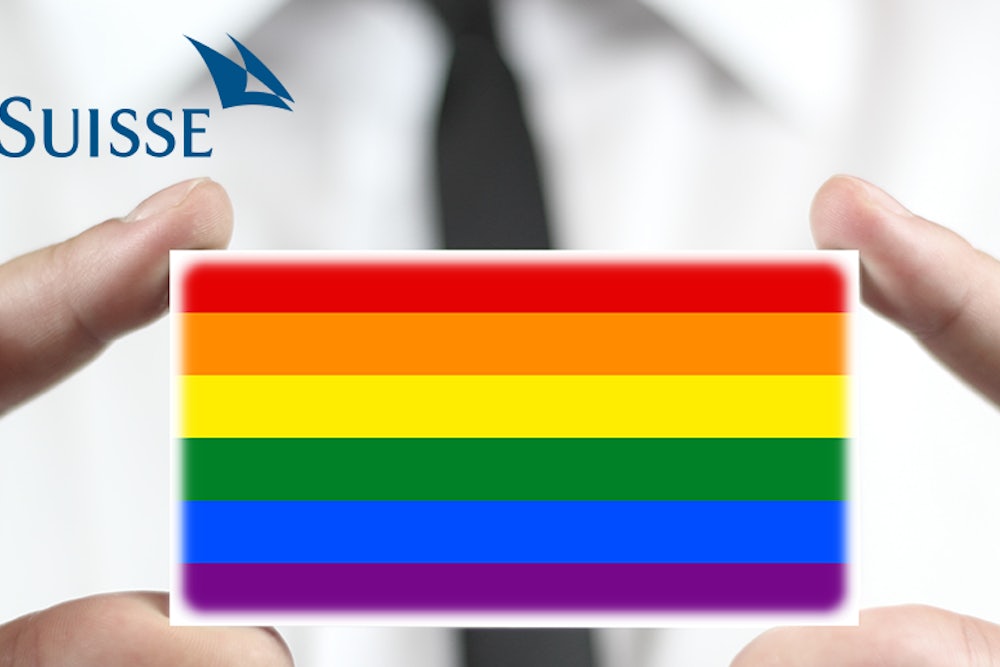This article is sponsored by Credit Suisse.
Brad Sears, executive director of the Williams Institute, a branch of UCLA School of Law, has spent the last 15 years encouraging policymakers and activists to forget everything they think they know. He wants them to consider data instead of turning to their assumptions.
Sears directs research about the LGBT community at the Williams Institute. When he began his work 15 years ago, he was part of a small group of researchers confronting a behemoth national conversation. “It’s harder for people to imagine this today, but if you go back to 2000, there were a number of assertions being made in policy debates about LGBT people that weren’t really backed with any research or evidence,” Sears explains. “While there had been some advocacy organizations that had tried to set up research arms, there wasn’t a lot of credibility for the research coming out of those institutions.”
You might think the Williams Institute's research is lofty and academic, considering its pedigree. But in fact, Sears and his team started their work with the basics, answering questions about the locations of same-sex couples. “One of the things we’re best known for is a map that shows the density by county of same-sex couples throughout the United States,” Sears says. “There were people in Congress at that time who would say, ‘There are no gay people in my district.’ So to have a map that showed almost all counties in the United States had same-sex couples identifying was really powerful.”
But data comes with its own set of problems, Sears explains. Broad national figures can sometimes obscure specifics. Because LGBT issues affect people differently depending on who they are and where they live, the Williams Institute has worked with corporate partners to create more nuanced analysis.
The institute's newest study, The LGBT Divide, which was completed through a partnership with Credit Suisse, reveals striking differences between general and specific data on LGBT income. Nationally, same-sex couple households have an income 12% higher than their different-sex counterparts. But if you look at a specific cross section of that data, the story it tells is very different. Same-sex couples with children who live in the Midwest earn about $20,000 less each year than their straight equivalents.
“In some cases, the national numbers really mask regional differences,” Sears says. “When you use these numbers to start identifying specific subpopulations, people understand LGBT people come from every walk of life and all over the income spectrum.”
What’s the reason for the wide regional variations? State law is a major factor. Federal law does not protect LGBT individuals from employment discrimination, so state governments must pass these protections. Most of the 21 states that provide legal protection based on sexual orientation are in the Northeast and Pacific regions, so life in the remaining 29 states—mostly in the Midwest, South and Mountain states—inevitably feels quite different for same-sex couples.
Sears says the study could help policymakers, constituents and society understand where the most reform is needed. In recent years, the South has become the focus of many activists’ efforts, but the situation in the Midwest and Mountain states is equally—if not more—dire. In both regions, about one-third of LGBT individuals report not having enough money to buy food. These levels of food insecurity are some of the highest in the country.
Although much of the nation lacks laws to protect LGBT people, corporations have begun to adopt their own protective practices nationwide. In 2002, the Human Rights Campaign released the first Corporate Equality Index (CEI), which rated companies based on the inclusiveness of their sexual orientation policies. The index inspired hundreds of businesses to become more transparent, providing more information about their practices to consumers.
Credit Suisse was one of those businesses. It has had a perfect score on the CEI for 10 years in a row. Just over a year ago, though, the bank decided to go one step further than its peers. In October 2013, it released its own index to track the performance of LGBT-friendly companies. It also unveiled the Credit Suisse LGBT Equality Portfolio to allow its clients to invest in a basket of companies with high scores on the CEI and high capital appreciation potential.
“I think corporate America has been instrumental in making the point that the LGBT community matters,” says Nicole Douillet, head of project innovation at Credit Suisse. “They’re employees, clients, customers and partners.”
Douillet developed the Credit Suisse Equality Index, and she’s motivated to help people invest in companies that align with their values. But she also realizes same-sex couples in certain regions have more basic concerns, such as home ownership. “The legal landscape is changing very rapidly across the country, so you really have to be on top of it,” she says. “For our clients who live in some of these states, it’s important to know that they face an uneven playing field. That was one of the things that motivated us to partner with the Williams Institute and dive into some of this research.”
In addition to the study, Credit Suisse also partnered with the institute to create an interactive data visualization, which helps viewers understand regional differences in LGBT education, economic insecurity, health and more.
Douillet says she and her colleagues are passionate about the benefits they offer their clients on a personal level through products like the LGBT Equality Portfolio and the work of informing the public through their partnership with the Williams Institute. “Just as our LGBT Equality Index proves quantitatively that a company’s support of LGBT employees—for example, providing health insurance for domestic partners—has no drag on performance, our work with the Williams Institute puts a number on the range of disparities that exist in our country and that need attention,” Douillet says. “What’s really going to move the needle and catch the attention of investors, policymakers and society is data.”
